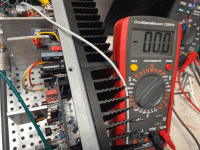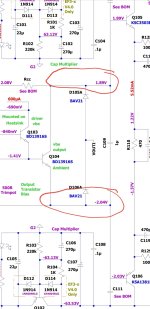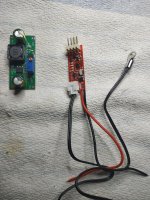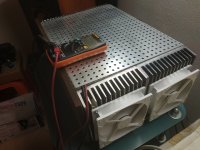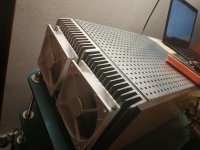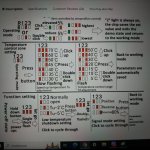Yes pricey, but I can’t get a 1200va Traffo shipped here for less than that(different in the states), and there are other nice QOL features on the SMPS like ELV standby control (no need to switch 230V or soft starts), LED outputs, 12v trigger inputs, power factor correction, built in OC protection.
And the LPS ripple is at 100hz, right in the audible annoying speaker hum, whereas the SMPS ripple is 60khz or higher.
I’d happy go big iron if it was as cheap as you can get it!
And the LPS ripple is at 100hz, right in the audible annoying speaker hum, whereas the SMPS ripple is 60khz or higher.
I’d happy go big iron if it was as cheap as you can get it!
For us fanatics , yes. A typical OEM 100W/ch will use a little as 8.2-10K X2 for both channels. MY HK has 6.8K X 4 and is rated 105/W.Isn't rule of thumb for power amps 10kuf per rail per 100W into 8 out?
The "trick' is for calculating rail collapse to coincide with device SOA - cheap $$$$ .
OS
To me the PFC is one of the biggest advantages for sure, no need to worry about line sag which is more important to us on 120V Mains. For example that amp I just finished on my bench with a 52V 1500VA transformer managed 320 watts into 4 ohms <120dB THD. With the Cobra SMPS it did 410 watts 4 ohm <120 THD. My bench supply is also running a cap multiplier so there is a bit more voltage drop there.
I already have another trafo now. I'd suspect that accurus 5X 125W amp's trafo needs to be 700'ish KVA to power 5 amps. I want a 4 channelCompared to a high quality 1500VA transformer + linear + caps it seems cheap. But yeah that is a steal for 99 bucks it all depends on what you want in the final product I guess, and budget of course
amp , BTW.
OS
Thank you Stuart I did install the updated condiguration and associated parts.I did try a few different gain level parts on q103 and it seems to fovor the higher HFE parts the bd136-16 were showing HFE of 155 and when i ran it with that part it tracked temp very nicely never got over 90 farenheight just barely warm to touch after 3 hours running at about 50 percent. I am happy with that
I have a nice Holmgren 5 channel Torroid transformer from a NAD 955 that i parted out its i great shape and did not see much use as the boards ⁷were defective It is FREE to anyone who will pay postage if interested PM me address and i can figure what postage is to you
I've had rather good luck get power transformers from faulty home theater amps on trademe.Yes pricey, but I can’t get a 1200va Traffo shipped here for less than that(different in the states), and there are other nice QOL features on the SMPS like ELV standby control (no need to switch 230V or soft starts), LED outputs, 12v trigger inputs, power factor correction, built in OC protection.
And the LPS ripple is at 100hz, right in the audible annoying speaker hum, whereas the SMPS ripple is 60khz or higher.
I’d happy go big iron if it was as cheap as you can get it!
Some of the higher spec models can have 600-800w power transformers and can be gotten for cheap.
I got an onkyo recently with a 620w transformer for $1. If you could find a matching pair of such faulty amps then your well on your way to a cheap dual mono setup.
There is a tonne of $1 reserve amps on trademe after their free selling offer last Saturday.
Price-wise not really. I live in Perth WA. My PS cost me A$197 for TWO 625VA 2x45V toroids (ONE 1kVA 2x50V toroid cost me A$221 for another project) plus TEN 10mF/100V Kemet caps for A$170 plus TWO 50A (5uA max DC reverse) bridges A$12 including shipping. So PS with two toroids cost me A$380 or about US$250. On top of it I added about US$20 in other parts such as diodes, resistors and small caps making PS smoother. I bought all my parts from: DigeyKey, Element14 and Mouser.Yes pricey, but I can’t get a 1200va Traffo shipped here for less than that(different in the states), and there are other nice QOL features on the SMPS like ELV standby control (no need to switch 230V or soft starts), LED outputs, 12v trigger inputs, power factor correction, built in OC protection.
And the LPS ripple is at 100hz, right in the audible annoying speaker hum, whereas the SMPS ripple is 60khz or higher.
I’d happy go big iron if it was as cheap as you can get it!
I never used modern SMPS, it certainly might be worth trying but it's not cheaper than a conventional one.
cheers,
If you want a new audiobrand xformer in the +1kVA region with 4 or more ecaps, bridge rectifiers ect, then SMPS like the one fireanimal ueses doesn't seem that expensive..
Just checking that you re set your meter to DC as the previous measurement was AC.
If it was dc was it in the mV range?
Depending on which way you installed R109 you need to turn the trimpot so that the resistance reduces to increase the bias.
If you turn the board over you'll see the pin numbers. You want to reduce the resistance between pins 1 & 2 please confirm that what you we're doing. Maybe send a photo and indicate what direction you're turning to confirm.
Stuart:
Yes, the meter has been set for DC mV (200 mV range). I suspect R109 is broken -- it's a 25-turn pot but, whichever way it is adjusted, I never reach a stop. It may take me a day or two but after double-checking it's broken I'll replace it and start the testing procedures in Section 20 (rev 37 has now been downloaded) again. Is it possible that R109 is my only problem?
Regards,
Scott
Attachments
Its hard to say at this point.Is it possible that R109 is my only problem?
It might be a good idea to try and validate a few of the other DC voltages shown on the schematic. The voltages shown are what you should measure approximately when the amplifier has the input shorted. If your not getting anything at those test points you tried, try at the nets I selected.
You can also print out the schematic and measure voltages and then write the voltage you measure on the schematic. You can then post your values to help with the diagnosis.
Good luck 🤞
Attachments
Looking at the $260 (hypex) , and Cobra $330 . a 1KW DIY SMPS might be worth it. But , everyone but (me) is scaredI never used modern SMPS, it certainly might be worth trying but it's not cheaper than a conventional one.
of a mixed SMD layout. I've reverse engineered the Hypex , full bridge soft switching with active PFC. The IC's are
commonplace (mouser). Layout is king , yet again. About <100$ (parts) for a Hypex/Cobra @ 1K+.
OS
Btw, if anyone is interested in a discounted, unused Cobra, send me a message. IIRC, rails are +/-32VDC
It’s likely that the Wolverine will be my last build for awhile due to life, work, etc., so I’d rather it go to use than sit and collect dust.
It’s likely that the Wolverine will be my last build for awhile due to life, work, etc., so I’d rather it go to use than sit and collect dust.
GB2 test build. For your viewing pleasure....
"Amp porn" , lots of LED's ... I like it !
How is temp-co with drivers + Q103 on main HS ?
OS
How is temp-co with drivers + Q103 on main HS ?
OS
Thats the preferred location, and the same as my bias response tests for the EF3-4.How is temp-co with drivers + Q103 on main HS ?
I know that ! Q103 is just my discussed 4 diode string with gain , affects ambient Q104 same as the diodes.Thats the preferred location, and the same as my bias response tests for the EF3-4.
I was curious what effect of having the drivers on the main HS would be. That would be the ultimate inverse
of 4 X MURS120's. Response would be slower than a (discontinued) thermaltrak NJL ... (MURS120+NJW0281).
Also , consider - driver SOA is reduced at higher Tc. There is the good and the bad.
OS
There are also different resistor values to accommodate for the different temperature coefficients between the EF3-3 and the EF3-4 due to the drivers being mounted on the main heatsink (EF3-4) or the separate driver heatsink (EF-3).
The EF3-3 values from the BOM would be used if EF3-4 for amplifier boards are mounted perpendicular to the main heatsink.
Its all been tested and varied many times.
The EF3-3 values from the BOM would be used if EF3-4 for amplifier boards are mounted perpendicular to the main heatsink.
Its all been tested and varied many times.
Τοποθέτησα αυτούς τους ανεμιστήρες pwm που ελέγχονται από έναν επεξεργαστή πάνω από τις ψύκτρες και μειώνω τη θερμοκρασία ώστε να μπορώ να έχω σταθερούς 38 βαθμούς Κελσίου πάνω από τις ψύκτρες. Παρόλα αυτά, το ρεύμα ηρεμίας μετά από μια ώρα πέφτει από 44mv σε 38 με 40mv η θερμοκρασία παραμένει στις ψύκτρες σταθερή στους 38 βαθμούς. Παίζω μουσική σε υψηλή ένταση. Φταίει η παγιδευμένη θερμοκρασία μέσα στο κουτί; Μπορεί κάποιος να εξηγήσει τον μηχανισμό του ρεύματος ηρεμίας και τον ρόλο του τρανζίστορ Q103 και Q104.
μήπως χρειάζονται μικρές αλλαγές στις αντιστάσεις ανάλογα με την κατάσταση??
μήπως χρειάζονται μικρές αλλαγές στις αντιστάσεις ανάλογα με την κατάσταση??
Attachments
Last edited:
- Home
- Amplifiers
- Solid State
- DIY Class A/B Amp The "Wolverine" build thread
